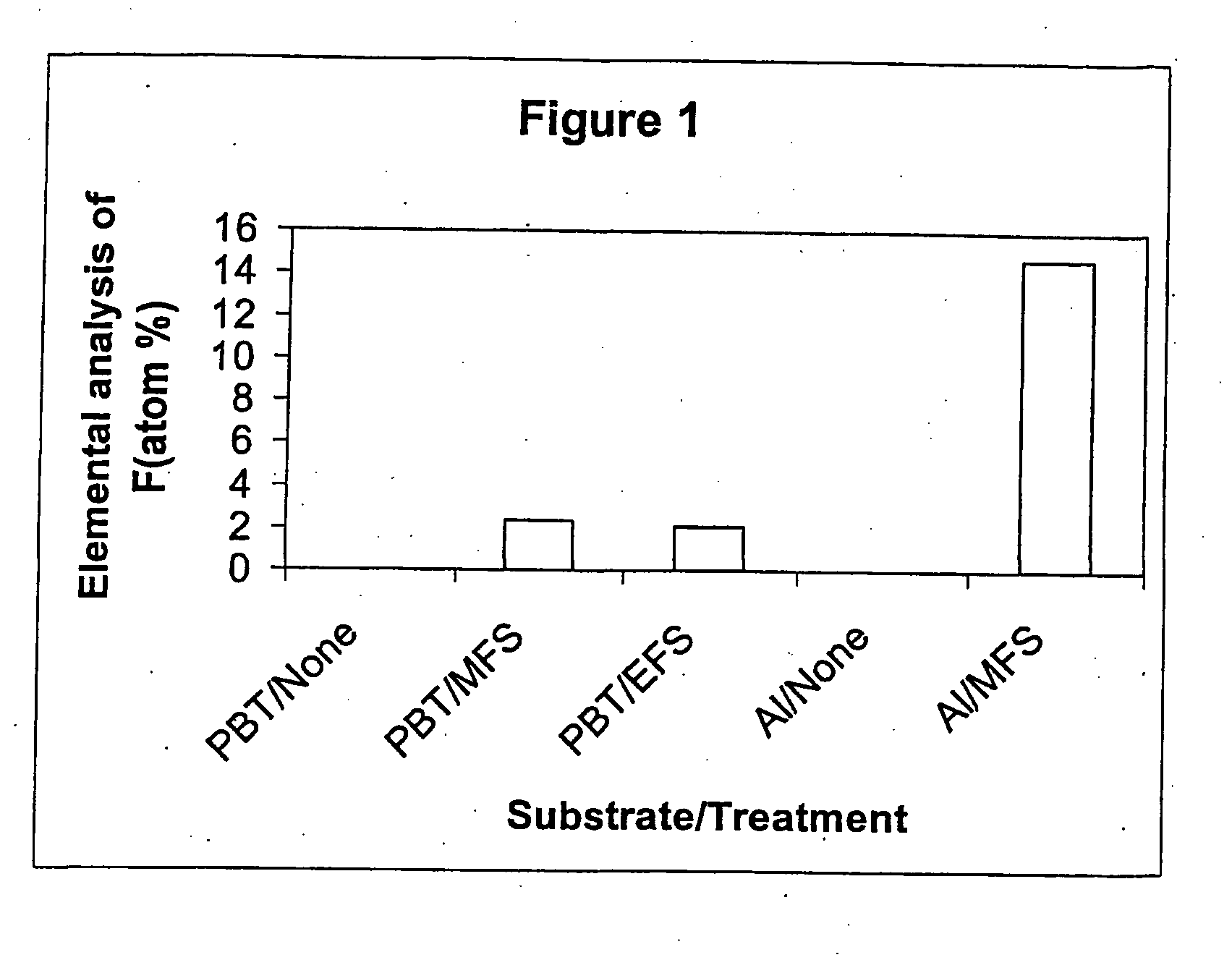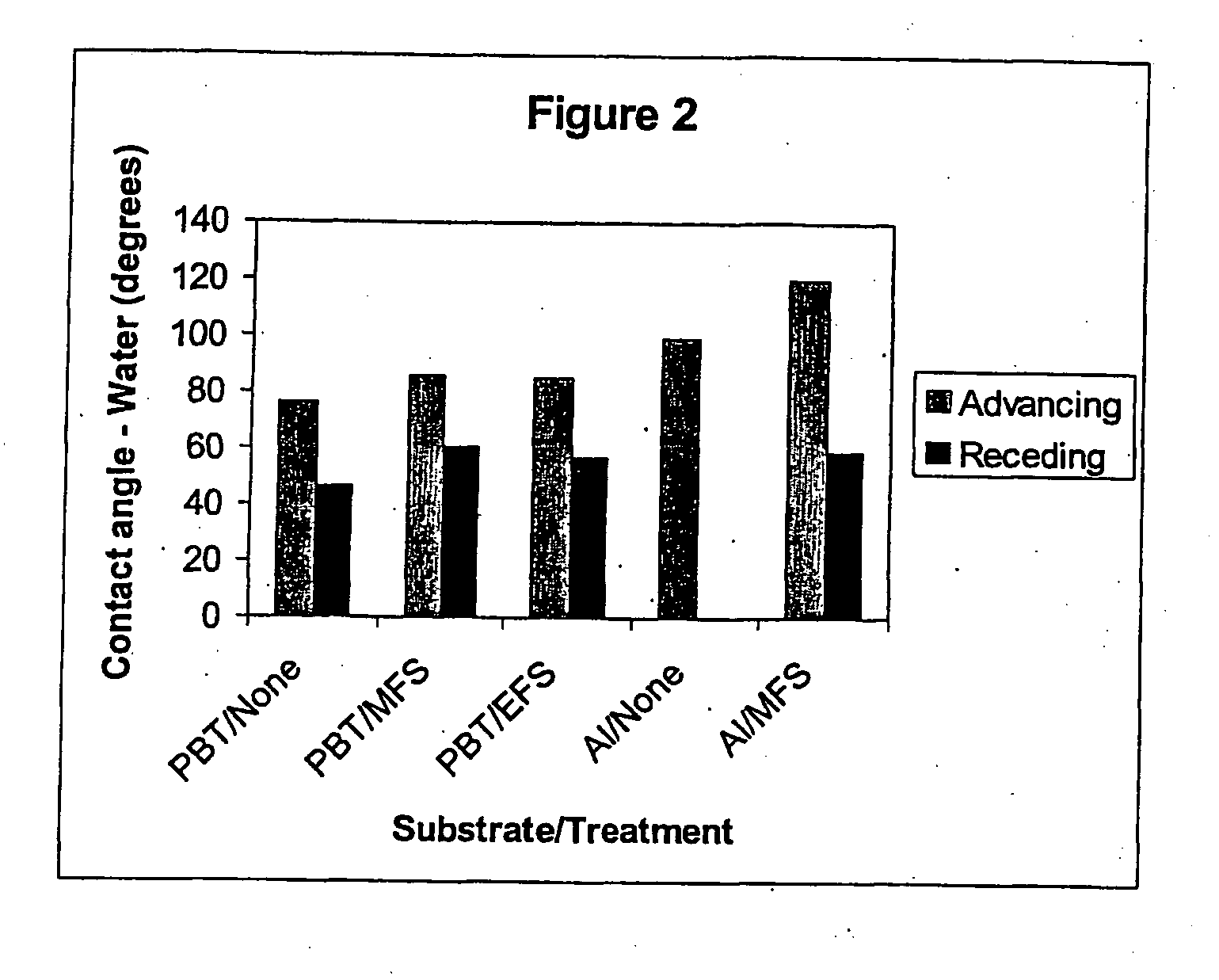Surface modification process
- Summary
- Abstract
- Description
- Claims
- Application Information
AI Technical Summary
Benefits of technology
Problems solved by technology
Method used
Image
Examples
example 1
[0092] This Example intends to demonstrate the effect of modifying metal and plastics surfaces with fluorine-containing silanes. Sheets of aluminium and polybutylene terephthalate (PBT) were decontaminated by ultrasonic agitation in 1,1,2-trichloro-1,2,2-trifluoroethane (Freon® 113). Silane solutions were prepared by dissolving 0.5 g of fluoroalkyl silane in 1 ml of Freon® 113. The silane moieties used for surface modification were 1H,1H,2H,2H-perfluoroooctyltrimethoxysilane (MWS) and 1H,1H,2H,2H-perfluorooctyltriethoxysilane (EFS). The Freon® 113 solution was diluted with 94 ml methanol, followed by 5 ml 1M acetic acid. The substrate was immersed in the solution for 5 min, after which it was removed at a rate of 0.5 mm / min. The polymers and aluminium were then heated for 10 min at 120° C. and 130° C. respectively, washed with Freon® 113 for 5 mins with ultrasonic agitation to remove unreacted silane, and allowed to air dry. A fresh fluoroalkyl silane solution was prepared for each ...
example 2
[0095] This Example is intended to demonstrate optimised conditions for the surface modification of aluminium. 30×10×0.47 mm aluminium strips were treated with the silane formulations detailed in Table 2, utilising the process described in Example 1.
TABLE 2FormulationsComponentsABCDMFS (g)0.50.250.250.25Freon ® 113 (ml)1.00.50.50.5Methanol (ml)94.094.01 M acetic acid (ml)5.0Deionised water (ml)6.0900.1 M hydrochloric acid (ml)10Toluene (ml)100
[0096] Surfaces were characterised by XPS and contact angle measurement with water. Results are shown in FIGS. 3 and 4.
[0097]FIGS. 3 and 4 indicate that a high drying temperature and the presence of 0.01 M hydrochloric acid to bring about acid hydrolysis of the fluoroalkyl silane and to activate the aluminium surface (Formulation C, as described in Table 2), produces the highest contact angle values and elemental F content.
example 3
[0098] This Example aims to demonstrate the advantages of modifying the surface of an aluminium pMDI can. Rectangles (20×10 mm) were partially cut from the walls of 19 ml cans (Presspart, UK), leaving a bridge in place. These cans were decontaminated, together with additional intact cans, by ultrasonic agitation in Freon® 113. After drying, a sample can was taken as a control, and the remaining cans were submerged in Formulation C for 30 min. The cans were then removed, dried at room temperature, and then placed in an oven at 130° C. for 10 min. They were then immersed in Freon® 113 for 5 min with ultrasonic agitation, and the partially cut rectangles removed for surface analysis by XPS (using an ESCALAB 5 device) and Auger Electron Spectroscopy (AES) (using a Varian Scanning Auger electron spectrometer).
[0099]FIG. 5 indicates that pMDI cans were successfully treated with Formulation C, with both XPS and AES data indicating higher levels of F in treated cans compared to controls. A...
PUM
| Property | Measurement | Unit |
|---|---|---|
| Temperature | aaaaa | aaaaa |
| Temperature | aaaaa | aaaaa |
| Volume | aaaaa | aaaaa |
Abstract
Description
Claims
Application Information
 Login to View More
Login to View More - R&D
- Intellectual Property
- Life Sciences
- Materials
- Tech Scout
- Unparalleled Data Quality
- Higher Quality Content
- 60% Fewer Hallucinations
Browse by: Latest US Patents, China's latest patents, Technical Efficacy Thesaurus, Application Domain, Technology Topic, Popular Technical Reports.
© 2025 PatSnap. All rights reserved.Legal|Privacy policy|Modern Slavery Act Transparency Statement|Sitemap|About US| Contact US: help@patsnap.com



